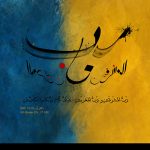The Islamic, Muslim, or Hijri calendar (Arabic: التقويم الهجري at-taqwīm al-hijrī) is a lunar calendar consisting of 12 months in a year of 354 or 355 days. It is used (often alongside the Gregorian calendar) to date events in many Muslim countries. It is also used by Muslims to determine the proper days of Islamic holidays and rituals, such as the annual period of fasting and the proper time for the pilgrimage to Mecca.
The Islamic calendar employs the Hijri era whose epoch was retrospectively established as the Islamic New Year of AD 622. During that year, Muhammad and his followers migrated from Mecca to Yathrib (now Medina) and established the first Muslim community (ummah), an event commemorated as the Hijra. In the West, dates in this era are usually denoted AH (Latin: Anno Hegirae, “in the year of the Hijra”) in parallel with the Christian (AD) and Jewish eras (AM). In Muslim countries, it is also sometimes denoted as H[1] from its Arabic form (سَنة هِجْريّة, abbreviated هـ). In English, years prior to the Hijra are reckoned as BH (“Before the Hijra”).
Months
1 Muḥarram مُحَرَّم forbidden A sacred month, so called because battle and all kinds of fighting are forbidden (ḥarām) during this month. Muḥarram includes ‘Āshūrā’, the tenth day.
2 Ṣafar صَفَر void Supposedly named thus because pre-Islamic Arab houses were empty this time of year while their occupants gathered food. Another account relates that they used to loot the houses of their enemies after defeating them in battle, leaving nothing behind.
3 Rabī‘ al-awwal رَبيع الأوّل the first spring Also means to graze, because cattle were grazed during this month. Also a very holy month of celebration for many Muslims, as it was the month the Prophet Muhammad was born.
4 Rabī‘ ath-thānī رَبيع الثاني the second spring
5 Jumādá al-ūlá جُمادى الأولى the first of parched land Often considered the pre-Islamic summer. Jumādá may also be related to a verb meaning “to freeze” and another account relates that water would freeze during this time of year.
6 Jumādá al-ākhirah جُمادى الآخرة the last of parched land
7 Rajab رَجَب respect, honour This is the second sacred month in which fighting is forbidden. Rajab may also be related to a verb meaning “to remove”, so called because pre-Islamic Arabs would remove the heads of their spears and refrain from fighting.
8 Sha‘bān شَعْبان scattered Marked the time of year when Arab tribes dispersed to find water. Sha‘bān may also be related to a verb meaning “to be in between two things”. Another account relates that it was called thus because the month lies between Rajab and Ramaḍān.
9 Ramaḍān رَمَضان burning heat Burning is related to fasting as in empty stomach one’s worldly desire will burn. Supposedly so called because of high temperatures caused by the excessive heat of the sun. Ramaḍān is the most venerated month of the Hijri calendar. During this time, Muslims must fast from pre-dawn till sunset and should give charity to the poor and needy.
10 Shawwāl شَوّال raised She-camels would normally be in calf at this time of year and raise their tails.
11 Dhū al-Qa‘dah ذو القعدة the one of truce/sitting This is a holy month during which war is banned. People are allowed to defend themselves if attacked.
12 Dhū al-Ḥijjah ذو الحجة the one of pilgrimage During this month Muslim pilgrims from all around the world congregate at Mecca to visit the Kaaba. The Hajj is performed on the eighth, ninth and the tenth of this month. Day of Arafah takes place on the ninth of the month. Eid al-Adha, the “Festival of the Sacrifice”, begins on the tenth day and ends on sunset of the twelfth, and during which war is banned.










